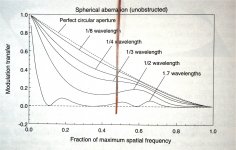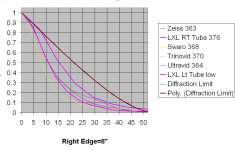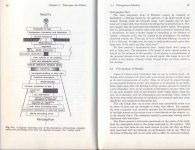henry link
Well-known member
Renze,
Thanks for the link to Tobias' very interesting article.
Below is an MTF plot from H. Suiter's book "Star Testing Astronomical Telescopes". It shows the detrimental effect on contrast from one almost universal aberration in binoculars, lower order spherical. If we assign to this plot a 20mm aperture to correspond to the effective aperture of an 8x binocular stopped down by a 2.5mm eye pupil in daylight then the 100% spatial frequency would be around 6 arc seconds. A person would need a little better than 20/8 eyesight to resolve that spacial frequency when it's multiplied by the binocular's 8x magnification to 48". Very few humans have eyesight acuity that good. A more typical human acuity (around 20/15) would fall at a spatial frequency of about 50% of that or around 90-100 arc seconds. I placed a red line on the chart at approximately that acuity. If we accept the Panavision standard of 30% contrast for a "sharp" appearing image it can be seen that an instrument corrected to 1/4 wave can meet that standard (for 20/15 acuity), but a 1/3 wave instrument can't, even though no smaller line pairs would be resolvable through the better instrument since the eye can still resolve line pairs at 20% contrast or even worse.
Most binoculars have a large amount of spherical aberration and many individual specimens have other defects on top of the SA. Total aberrations approaching 1 wave are common at full aperture (even in "alpha" brands) and when the effective aperture is reduced in daylight most are still worse than 1/4 wave. It's a wonder that any of them look "sharp".
Henry
Thanks for the link to Tobias' very interesting article.
Below is an MTF plot from H. Suiter's book "Star Testing Astronomical Telescopes". It shows the detrimental effect on contrast from one almost universal aberration in binoculars, lower order spherical. If we assign to this plot a 20mm aperture to correspond to the effective aperture of an 8x binocular stopped down by a 2.5mm eye pupil in daylight then the 100% spatial frequency would be around 6 arc seconds. A person would need a little better than 20/8 eyesight to resolve that spacial frequency when it's multiplied by the binocular's 8x magnification to 48". Very few humans have eyesight acuity that good. A more typical human acuity (around 20/15) would fall at a spatial frequency of about 50% of that or around 90-100 arc seconds. I placed a red line on the chart at approximately that acuity. If we accept the Panavision standard of 30% contrast for a "sharp" appearing image it can be seen that an instrument corrected to 1/4 wave can meet that standard (for 20/15 acuity), but a 1/3 wave instrument can't, even though no smaller line pairs would be resolvable through the better instrument since the eye can still resolve line pairs at 20% contrast or even worse.
Most binoculars have a large amount of spherical aberration and many individual specimens have other defects on top of the SA. Total aberrations approaching 1 wave are common at full aperture (even in "alpha" brands) and when the effective aperture is reduced in daylight most are still worse than 1/4 wave. It's a wonder that any of them look "sharp".
Henry
Attachments
Last edited:








